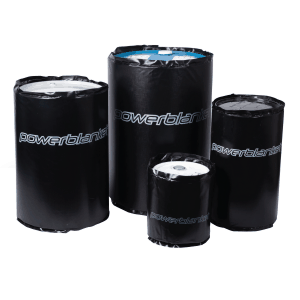Wooden barrels were the first containers to ship commercially produced oil in the 1850s out of Titusville, Pennsylvania. By the 1860s, producers sought to standardize the barrels at 42 gallons. However, the most significant change to barrels came in 1905 when John D. Rockefeller’s Standard Oil started ordering mass-produced cold rolled carbon cylindrical steel containers holding 55 gallons and featuring ribs that provide rigidity and strength.
Drum measurements are unique because they have several factors to consider. The 55-gallon drum diameter, height, and top opening have specific measurements that must be exact for the drum to function correctly. Knowing the standard dimensions will help you with your daily tasks if you work in the shipping or packaging industry.
This article will provide information about those dimensions, why they are so important, and tips on measuring them correctly.
If temperature control of your drums is becoming an exhaustive struggle, look no further. Our versatile 55-gallon drum heaters fit steel, plastic, and fiber drums to maintain precise temperatures. With its durable construction and UL certification, you can count on consistent heating performance for all your temperature-sensitive products.
Types of 55-Gallon Drums
Before determining dimensions, we must first know what type of drum it is. There are three primary materials for making 55-gallon drums:
- Steel or carbon steel
- Cardboard or fiberboard
- Plastic – including polyvinyl chloride (PVC), high-density polyethylene (HDPE), and nylon.
Knowing which material is essential if you order liners or 55-gallon drum and barrel heaters because each has a unique shape and dimensions.
There is an additional feature to drums that will affect their dimensions. They can have an open-head or closed-head.
Open or Closed Head?
An “open” head means the entire top end is removable, giving easy access to the contents inside. They are suitable for semi-solid and pourable substances such as sand, dried beans, soil, gravel, etc.,
The top on a “closed,” 1A1, or tight head drum, is permanently attached. It has a 2” or 3” bunghole and a 1/2” vent hole. Closed-head drums are best suited for low-viscosity liquids, such as water, gasoline, crude oil, and other fluids. The 2″ bung fits appropriate piping and pumping systems for safe loading and dispensing without spilling.
Open-head type barrels will be slightly larger.
What Are 55 Gal Steel Drum Dimensions?
The steel 55-gallon barrel is the most common container for storage or shipping bulk materials. These steel barrels are cylindrical with two ribs around their circumference for strength and to make it easier to roll. Below are the typical 55-gallon barrel dimensions for a steel drum:
| 55 Gal Drum Dimensions – Steel | ||
| Closed-Head | Open-Head | |
| Exterior Height | 33” | 34-3/4” |
| Exterior Diameter | 23” | 24-1/2” |
There can be slight variances from manufacturer to manufacturer.
What Are The Dimensions of A 55-Gallon Plastic Drum?
Typically blue, plastic drums are suitable for storing chemicals and liquid food-grade ingredients. The diameter is the same for plastic and steel, but the blue barrel is slightly shorter. The blue plastic drum features a smaller opening on the top than the typical drum, which makes it easier to seal.
| 55 Gal Drum Dimensions – Plastic | ||
| Closed-Head | Open-Head | |
| Exterior Height | 34-3/4” | 36-3/4” |
| Exterior Diameter | 23-1/4” | 22-7/8” |
What Are The Dimensions of A 55-Gallon Fiber Barrel?
Fiber drums are lightweight, durable, and sustainable containers that can hold up to 400 lbs. (181 kg). They are ideal for powdered or dry granular products for the food and pharmaceutical industries. They feature full open tops, allowing for quick filling and dispensing.
| 55 Gal Drum Dimensions – Fiber | |
| Fiber Cover-Lever Lock Ring Closure | |
| Exterior Height | 35-1/2” |
| Exterior Diameter | 22-3/8” |
What Is The Radius Of A 55-Gallon Drum?
If you know the dimensions of the drum and the radius, you can find its volume. The radius of a drum is the distance from the center of the opening to the edge. Standard steel drums have an internal radius of 11.25 inches, meaning that the inner diameter of these barrels is 22.5 inches.
The steel adds an extra half-inch, making the external diameter 23 inches. The thickness of the metal will vary from brand to brand. One drum may have a smaller radius than another, even if they are the same volume.
If you need to find the radius of a drum container, follow these steps:
- Place the barrel on a flat surface.
- Place a measuring tape over the opening at the widest point.
- The widest measurement is the diameter.
- Divide the diameter by 2 to get the radius measurement.
If you need to calculate the barrel’s volume, use the formula Volume = π r2 h, where r equals the radius and h equals the height.
How to Measure the Dimensions of a Drum
To measure a drum’s dimensions accurately, follow these steps:
- Place the drum on a flat, firm surface.
- Place a tape measure across the opening from one edge to the other to measure the width or diameter.
- Measure the height of the barrel from the base to the top.
- Check the measurements against the manufacturer’s specifications.
What Is The Weight Of A 55-Gallon Drum
The average steel drum weighs 48 pounds (22kg) when empty, a plastic barrel weighs 21.5 lbs. (9.8 kg), and a 55-gallon fiber barrel weighs 16 lbs. (7.25 kg.).
A 55-gallon steel barrel filled with oil weighs 443 lbs (201 kg). Filled with water, it weighs 484 lbs (220 kg).
Water weighs 8.34 lbs. per gallon, and oil weighs 7.2 lbs. per gallon. You can calculate total barrel weights by multiplying them by the number of gallons in the container.
How Do You Stack 55-gallon Drums?
Here are a few recommended practices when storing full steel barrels:
- Do not stack over 4 high if the temperature exceeds 30°C (86°F) for prolonged periods to prevent leakage.
- Storing steel containers directly on the floor causes corrosion.
- When side-stacking barrels, use a rack designed for barrels and don’t stack over three high to prevent crushing and leakage.
- Pallets should have uniform surfaces that evenly contact the ring on the top of the drum.
- Drums should not overhang the pallet to provide a balanced load.
Preventing Barrels from Freezing
Many manufacturing processes use products straight from the drum. They may pour out using gravity or with a pump. Some products require heating to reduce their viscosity. Others, such as water-based products, must not freeze if stored in areas subject to winter weather.
The solution is 55-gallon drum heaters and insulation. They maintain a set temperature without overheating the product. Always use a 55-gallon hazardous area drum and tote heater for flammable or explosive products.
How Do You Move a 55-Gallon Drum?
Do you know why the 55-gallon drum is the industry standard? It’s the largest container a single person can move without needing a forklift. Moving a 55-gallon drum is easier than you might think. There are several ways that you can move a drum, including:
- Pulling the drum using a chain or rope.
- A drum dolly makes it easy to push it where you need it to go.
- Rolling the drum on its side provided the floor is even and the bung caps don’t leak.
What Can You Store In A 55-Gallon Drum?
The original 55-gallon-sized barrels stored and shipped bulk crude oil. Today they hold any liquid or bulk products such as livestock feed, grain, seeds, coatings, oils, chemicals, and various food products. They can also store other bulky materials that are not liquids or powders, like scrap metal, glass, or even medical supplies.
Steel and plastic drums are best for holding liquids or heavy materials. Plastic drums won’t rust and are the best choice for outdoor use. Fiber barrels are unsuitable for wet products.
Always cover barrels with a 55-gallon drum heater if they carry products prone to freezing or need a stable temperature for dispensing.
Frequently Asked Questions
Are all 55-gallon drums the same size?
While steel and stainless steel 55-gallon drums generally have standard dimensions, plastic drum sizes can vary slightly between manufacturers, and fiber drums often allow for customizable heights.
How many 50 lb bags of corn does it take to fill a 55-gallon drum?
A 55-gallon steel drum can typically hold four 50 lb bags of corn, but with strategic placement, it can accommodate up to six bags.
What are the dimensions of a drum?
Standard 55-gallon drums usually measure between 33 to 36-3/4 inches in height and 22-3/8 to 24-1/2 inches in diameter, depending on the material and design.
Will a 55-gallon barrel fit in a car?
A standard 55-gallon drum, with a diameter of 23 inches and a height of 35 inches, can fit in the backseat of some larger sedans or SUVs, but it's always best to measure your vehicle's space first.
Powerblanket's industrial drum & barrel heaters provide even and consistent heating, eliminating waste and lowering costs.







